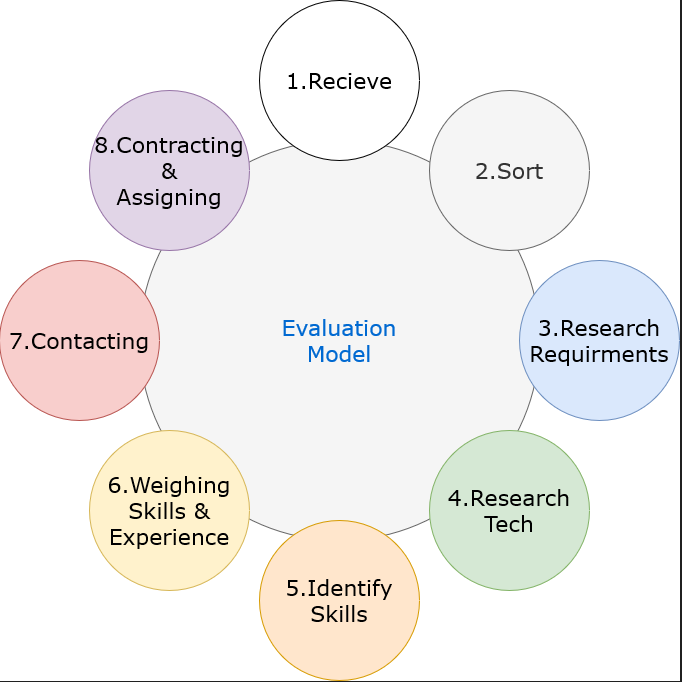
- Details
- Geschrieben von Joel Peretz
- Kategorie: IT
- Zugriffe: 16254
Evaluating Professional Profiles in the IT Market: Navigating Political Influences and Project Requirements
A Strategic Framework for Aligning Expertise, Market Demands, and Policy Trends in IT Projects
External Influences
To begin with an overview of how skills are assessed in professional profiles, it is essential to highlight the impact of recent developments in both the IT market and the political landscape in Germany.
Although the full impact may not be evident to those outside the industry, the results in the field must be significant. As the economic crisis deepened, statements from Germany's economy suggested a deliberate effort to 'cool down' the market. Whether this explains the current recession or is just part of a broader strategy remains unclear. However, in our effort to focus on the core topic—resources—it’s important to acknowledge that these influences on mood, morale, and market transparency are also affecting the economy.
This is a broad topic that warrants further exploration in a separate article.
There are signs that independent IT professionals, who once thrived in the free market, are being increasingly pressured to shift towards permanent employment. While we won't get deeply into the political aspects, it's clear that this transition is being influenced by the evaluation of skills. In freelancing, price and performance are driven by market dynamics, allowing a profile to be undervalued or deemed insufficient based on associated hourly or daily rates. In this discussion, we aim to explore how professional profiles are assessed, drawing from extensive experience in freelancing projects and temporary employment, including Germany's ANÜ (Arbeitnehmerüberlassung), which essentially parallels manpower leasing.
Whatever peaceful or silent revolution might be implied on official government platforms, the ongoing shift towards socialism—through the redistribution of resources, wage suppression, and increased control via digital mechanisms—also plays a role in influencing social dynamics. This shift may subtly shape the perspectives of individuals in HR or consulting firms, often without them realizing the impact through self-reflection.
Furthermore, the hindrance and delays in bureaucratic processes—allegedly exacerbated by the tolerated underemployment or mishandling of these issues—contribute to accelerating the downward spiral. Reversing this negative trajectory requires not just the will of politicians but, more importantly, the collective action of the people themselves. This individual engagement will become evident when we get into the practical aspects of interpreting and translating professional profiles.
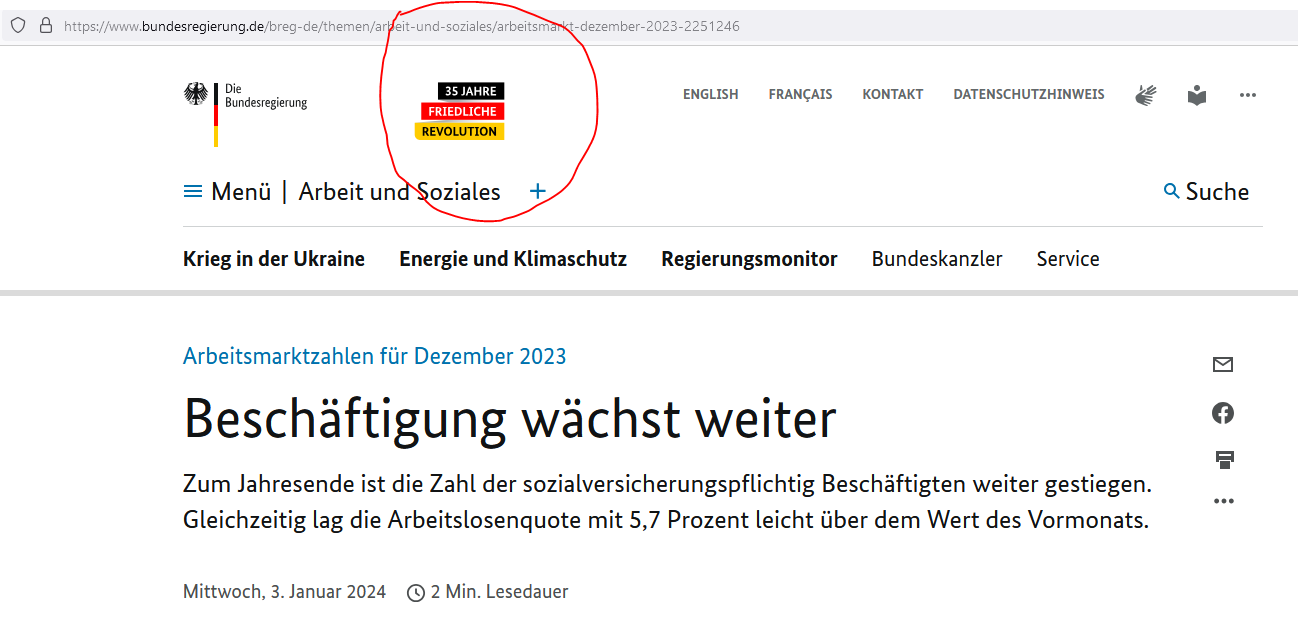
Source: www.bundesregierung.de
Evaluation of Skills and Professional Experiences
It is impossible to cover every subject in the IT sector or account for all possible scenarios and events. This discussion aims to provide thought guidelines on how to approach professional profiles and the current market situation. It is essential to remember that actions taken today will yield results in the future, impacting not only specific segments of the industry but society as a whole. Let’s focus on the core subject at hand.
First, it's crucial to emphasize that while support from friends is invaluable during a crisis, relying solely on it is insufficient. This is not a new concept, especially in discussions about networking, which has often been highlighted. People frequently discuss the importance of communication and soft skills, but these aspects are still often overlooked in today’s interactions.
In my case, the assistance of two colleagues, who proved to be friends as well, was indispensable. Their support extended over the weekend and during late hours, without which I wouldn’t have been able to shift towards the necessary improvements in my profile and establish connections with valuable people, ultimately strengthening my position.
However, not relying solely on such support means aspiring to target both broad and specific goals—to aim both low and high simultaneously. Since the evaluation of project and job requirements is beyond one’s direct control, it doesn’t make much sense, or may even be impossible, to meticulously read every detail and ensure 100% alignment in experience and skills.
Consider a call for support from a bank, a delivery service, or even when a postal package is stuck. When dealing with companies, clients, or key account managers, the human element is critical. However, this human interaction often becomes diluted with the use of automated systems. For instance, smart answering machines may prompt users with questions, yet they frequently fail to comprehend responses, especially when time is of the essence. This disconnect can exacerbate the challenges faced during stressful situations.
Regardless, there are individuals—often narcissistic in nature—who sense your impatience or frustration and deliberately complicate communication. Some may feign assistance, merely ticking boxes or forwarding your inquiries, ultimately leading you into a labyrinth of attempts to resolve the issue.
It's crucial to recognize when things are amiss; however, many will turn a blind eye instead of informing you, even when they are aware of your confusion. I experienced this firsthand during a recent interaction with the tax authorities while trying to clarify an issue.
In instances where it becomes clear that someone is intentionally obstructing your progress or that there is no common ground for understanding, it may be more effective to detach both verbally and physically from the situation if appropriate.
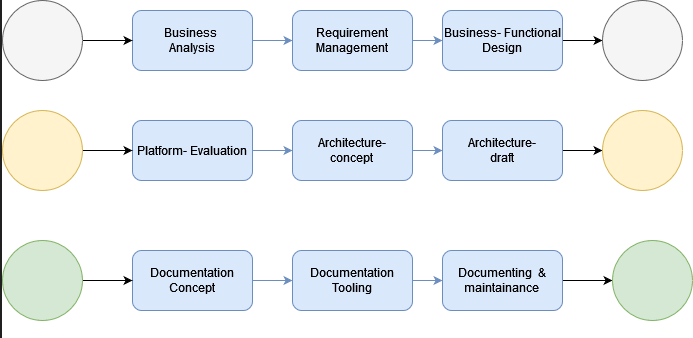
Let’s Get Down to Business
Navigating the IT landscape can be particularly challenging for less experienced professionals. Even with thorough research, those who have been in the industry for a year or less often struggle to engage meaningfully with seasoned experts. This lack of experience can hinder their ability to grasp the complexities of the questions they pose.
In many cases, companies allow these junior employees to reach out to highly experienced individuals, such as architects, under the guise of professional development. This practice often turns into an unintentional arrangement for free training, as the less experienced employees seek guidance and insight without fully understanding the intricacies of the role they aspire to fill.
It is often unclear whether a project is genuine or merely a façade—designed to gather profiles, conduct market research on pricing, or solicit opinions on specific subjects or tools. Such practices are not only unethical but can also skirt legal boundaries.
Consider the scenario where a candidate is invited for an in-person interview five hundred kilometers away, despite the company's knowledge that they do not intend to hire them. Instead, they aim to extract valuable insights and best practices from the candidate's expertise. This situation becomes particularly problematic when the candidate incurs significant travel expenses, potentially several hundred Euros, just to share their knowledge under false pretenses.
How would one characterize such behavior? It seems to reflect a troubling trend in the industry, where companies may prioritize information gathering over genuine recruitment efforts, ultimately undermining trust and respect in professional relationships.
Thanks to a colleague who took the time to critically examine my CV and provide interactive feedback, I was able to make significant improvements. One of the key points of criticism was related to the formatting and the need to keep the text concise to enhance readability and create a clean visual impact. He also pointed out that listing numerous short-term projects can be off-putting to recruiters.
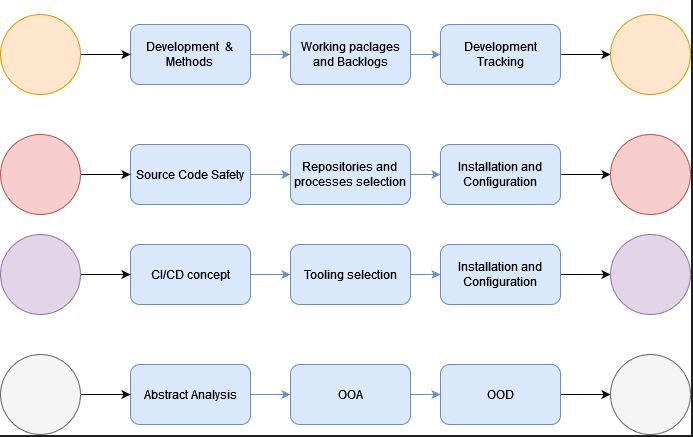
There are always different perspectives to consider. Short assignments can, through the lens of overly cautious and negative observers, be viewed as problematic. The question, "What caused it to be so brief?" can overshadow other trivial factors. However, it is entirely plausible that an experienced external resource, known for their problem-solving skills and ability to quickly adapt to complex environments, is hired for short-term engagements—often at a higher cost than a salaried employee.
This expense can often be misleading. If leadership is veering in the wrong or suboptimal direction, the cost of bringing in a skilled consultant might ultimately save the company significantly more in the long run, preventing costly missteps.
Another common scenario involves a senior client manager assigning a consultant, yet failing to control the resulting conflicts, which can lead to situations of workplace mobbing. Additionally, the extensive materials provided, even with just two days for preparation, can be overwhelming. This might create unrealistic expectations where the client assumes the consultant will work tirelessly for weeks, yet will only compensate them for a maximum of eight hours a day.
Consider a consultant who lives 300 km away. The limited time available after fulfilling personal errands—such as eating, sleeping, maintaining their vehicle, or attending to health appointments—makes it nearly impossible to meet such demands.
As a key account manager or HR professional, it’s crucial to approach situations with empathy and understanding. By asking open-ended questions and considering, “What would I do in this situation?” you can better navigate the complexities that arise when integrating a consultant into a new project.
Imagine a consultant who must quickly acclimate to a new environment, with only three days to become somewhat productive. Alongside their IT responsibilities, they need to familiarize themselves with the client's company culture, locate essential amenities (like restrooms and dining options), and learn the names and roles of key personnel. This includes organizing supporting data and documentation, identifying the most relevant documents, and understanding the necessary tools and licensing requirements.
All of this becomes even more challenging if the onboarding process has not been adequately prepared. If the consultant feels unwelcome or viewed as a disruption by their new colleagues, it can create an isolating atmosphere. In such scenarios, complaining about the lack of support is often not an option for external consultants. They must independently navigate communication issues and interpersonal dynamics.
The stakes are high; if conflicts arise or if the consultant is perceived as a problem, their contract may not be renewed or they could be removed from the project altogether—without ever having had the chance to perform the functions for which they were hired.
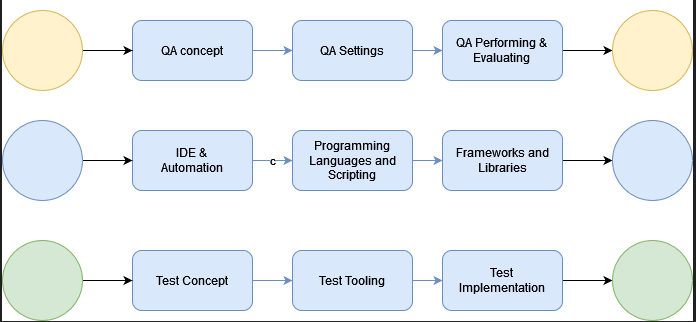
Essential Components of Computerized Information Systems
In this section, we will explore the essential components that form the backbone of any computerized information system. Each building block will be examined with a focus on how it informs the evaluation of professional profiles in various dimensions. The following elements are key to understanding these systems, although our exploration will not be limited to them alone.
Computer systems, platforms, and architectures are interconnected and vary depending on the type of system and its specific requirements. While it's possible to outline the building blocks in a straightforward, linear manner, we will approach the subject with a more flexible, analytical perspective to examine how profiles can be evaluated based on different factors.
This open-ended text will highlight ways to assess skill sets, focusing on refining one’s abilities to better meet project or senior-level job requirements. Finally, I will provide an overview on how to individually prepare for advanced roles or project opportunities, which can then be tailored to each person’s unique career goals and strengths.
Again, it is impossible to address every potential scenario in the broad spectrum of cases. However, the goal here is to provide a general idea, particularly for novice evaluators or those who may not be deeply familiar with the core subjects. This approach aims to help them see the interconnections between various skills and competencies.
Platforms: The foundational technology supporting applications and services, including both operating systems and cloud infrastructures. Understanding these platforms is crucial for assessing a professional's technical expertise and adaptability to different environments.
Frontends: The user-facing elements that provide interaction interfaces, such as web and mobile applications. Evaluating skills in front-end technologies can reveal a professional's capability in user experience design and client interaction.
Backends: The server-side infrastructure, encompassing the logic, database interactions, and processing that enable front-end functionalities. A professional's knowledge of backend systems can be indicative of their problem-solving abilities and system architecture understanding.
Databases: Systems for managing and storing data, including both relational databases (like MySQL) and NoSQL options (such as MongoDB). Proficiency in database management can highlight a candidate's analytical skills and data handling capabilities.
Networks: The communication frameworks that connect various parts of the information system, allowing for data exchange and user interaction. Understanding network fundamentals can be essential for evaluating a professional's capability in ensuring seamless connectivity and security.
Servers: Hardware or virtual machines hosting applications and managing resources. Knowledge of server management can demonstrate a professional's operational expertise and ability to optimize performance.
Artifacts: Deliverables produced during the software development lifecycle, such as documentation and code. The ability to produce and manage artifacts effectively can indicate a professional's attention to detail and organizational skills.
Formats: Structured representations of data, including JSON, XML, and CSV. Familiarity with data formats is important for assessing a professional's capability in data manipulation and integration.
Protocols: Established standards for data communication, such as HTTP, FTP, and TCP/IP. Understanding these protocols is critical for evaluating a professional's technical communication skills and their ability to work within diverse systems.
|
|
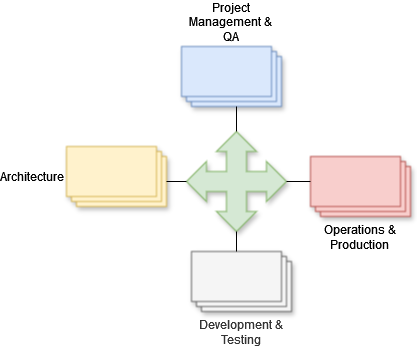 |
Let’s continue by getting deeper into the topic as we progress, expanding on key ideas as they emerge
In essence, we are dealing with an abstract realm where invisible machines and their components work together to process raw materials and produce outcomes. These machines can also trigger other systems to process different raw materials, creating a chain of interconnected operations. Every machine, whether operated by humans or automated systems, follows a start-to-finish cycle in its tasks. Much like in chemistry, it's vital to know how to monitor, pause, or troubleshoot a machine's function at any given moment. If something malfunctions, we need the skills to diagnose and repair it, ensuring it runs smoothly again.
The process doesn't end there. It's equally important to refine and optimize these machines for greater efficiency or to reuse their designs to create new, more complex systems. Since these machines can integrate with other systems, forming a more extensive operation, it's crucial to plan for seamless integration from the start. Think of an invisible engine composed of numerous parts—gears, belts, pumps, wires—each working together in harmony.
Moreover, building a complex, modern engine requires meticulous planning, right from its design to its installation and beyond. Even after the machine has been phased out, its legacy components must still be maintained, serviced, and supported with spare parts. This holistic approach ensures the entire lifecycle of the machine is considered and managed effectively.
When looking for a senior-level resource, it's important to recognize that they may not necessarily cover all phases of the system's entire lifecycle in one current project. While it can happen, such cases are relatively rare. Senior resources typically focus on specific critical areas, bringing their expertise to optimize or lead certain phases of a project. Their value lies in their ability to provide deep insights and leadership, rather than covering every aspect of the lifecycle in full.
This requires not only understanding the life cycle of a system from the start but also grasping the concurrently running processes. In large companies, there are always multiple stages and phases occurring simultaneously, and tasks can be split or merged, occasionally requiring support in adjacent areas or involvement in evaluations and decision-making. Therefore, even for a specialized role, having a broad range of skills and knowledge is crucial.
Additionally, strong verbal and written communication skills are essential, as there will always be interactions with different stakeholders, including management, clients, suppliers, vendors, and fellow developers at various levels within or outside the company. Company-specific proprietary terms, which may change due to upgrades or shifts in focus, need to be quickly and accurately understood by the resource during discussions or meetings.
Experience accumulated over years plays a crucial role in navigating these complexities effectively.
Understanding architecture is similar to planning an engine unit, as mentioned previously. On one hand, we have the vision for business needs, and on the other, the instruments available to us. Beyond proficiency with digital communication tools, it's crucial to document and adapt to internal reporting and documentation standards. This includes familiarity with standard office products and any specialized tools. A well-rounded profile should highlight the ability to quickly meet internal requirements.
Software development often involves a wide range of tools and techniques. In the market, there are roughly four to five main "grouped" and combined products used for distributed system development. A consultant should be proficient with at least one of these. At higher levels, this familiarity is generally expected, as it is gained through work experience. From version control and repositories to project tracking, planning tools, modeling and diagramming, and even time reporting, these tools are integral to a project’s success. If not a proprietary client solution, the knowledge a consultant requires should be evidenced by project experience.
A profile should list tools in a way that reflects awareness of the relevant subjects and categories. Identifying experience with processes based on the mentioned tools is not always straightforward, but it is achievable. Some tools, like those supporting BPMN (Business Process Model and Notation), serve dual purposes: designing processes and generating artifacts for the execution engine. Numerous cases like these can be discussed and further explained during the expansion of this topic.
At the programming level, which forms the foundation for creating designs, the emphasis must be on core methods and fundamentals. Proficiency in essential programming languages like Java, C++, and Python is crucial, especially with a strong focus on Object-Oriented concepts and implementation. While using various supplementary frameworks and tools is part of the development process, the central priority remains on mastering these primary languages.
It’s also vital to distinguish between these primary languages and supplementary technologies such as scripts, domain-specific languages, and interpreted languages. For instance, even though Scala compiles to Java bytecode, the essential expertise still lies in Java. Similarly, using integrated development environments like IntelliJ or Spring Tool Suite (STS) requires familiarity with framework integration, server binding, and automating cloud deployments.
Architects play a key role in assessing problems and conducting feasibility tests, often building prototypes to explore different solutions. Decisions about tools and frameworks are frequently influenced by prior projects and economic considerations, highlighting the importance of adaptability based on an organization’s preferences.
From this discussion, it becomes evident that evaluating skills can be complex, even if much of it seems straightforward. Experience serves as a crucial factor. A consultant’s profile should reflect familiarity with higher-level concepts and methodologies common in projects. This includes practices like Extreme Programming or Agile, Clean Code principles, Pair Programming, modularity, design patterns, anti-patterns, cohesion and coupling, resilience, scalability, and testing. Test frameworks, methods, and the integration of quality assurance processes and tools also play a crucial role in protecting and improving the source code base.
I will pause here to reassess the focus and better expand on verifying consultant profiles. The requirements for a junior Java programmer, business requirements analyst, cloud platform builder, or release manager differ substantially. This distinction may be the subject of a future article. For now, it’s clear that conveying this breadth of knowledge in one concise piece is challenging. Still, this approach—categorizing tasks, understanding contexts, and researching the runtime or project management environment—is essential for identifying the right skills.
This article will be revisited periodically to refine its clarity and add more value. Revisiting and updating it to ensure relevance would not be a bad idea—it is, so to speak, 'reentrant.
To be continued ...
Glossary
Here’s a glossary table based on the article, summarizing key terms and concepts along with their definitions:
| Term | Definition |
|---|---|
| Evaluation of Skills | The process of assessing an individual's competencies and experiences within the context of the IT industry, including their ability to navigate complex environments. |
| Professional Profiles | A summary of an individual's skills, experiences, and qualifications, often used for job applications or networking within the industry. |
| Networking | Building and maintaining professional relationships to facilitate support, opportunities, and information sharing in a business context. |
| Soft Skills | Personal attributes that enable someone to interact effectively and harmoniously with others, crucial for communication and teamwork. |
| Human Element | The interpersonal aspects of communication and relationships that can influence outcomes in professional settings. |
| Automated Systems | Technology that performs tasks without human intervention, which can sometimes hinder effective communication. |
| Narcissistic Behavior | A personality trait characterized by a lack of empathy, often leading to manipulation in professional interactions. |
| Project Feasibility | An assessment of the practicality and potential success of a project, including its economic and logistical aspects. |
| Consultant | A professional who provides expert advice in a particular area, often brought in to guide projects or solve specific problems. |
| Onboarding Process | The method of integrating new employees or consultants into an organization, including training and familiarization with the company culture and procedures. |
| Computerized Information Systems | Integrated systems that manage and process information, crucial for organizational operations and decision-making. |
| Platforms | The foundational technologies that support applications and services, including operating systems and cloud services. |
| Frontends | The user-facing components of applications that allow users to interact with the system. |
| Backends | The server-side operations and infrastructure that support the functionalities of front-end applications. |
| Databases | Systems for storing and managing data, essential for application functionality and data retrieval. |
| Networks | The systems that connect computers and devices, facilitating communication and data exchange. |
| Servers | Hardware or software systems that provide resources, data, services, or programs to other computers, known as clients. |
| Artifacts | Documents and deliverables produced during the software development lifecycle, such as code and project documentation. |
| Formats | Structured data representations (e.g., JSON, XML) used for data interchange between systems. |
| Protocols | Standardized rules for data communication that ensure devices can communicate effectively (e.g., HTTP, FTP). |
| Object-Oriented Programming | A programming paradigm based on the concept of "objects," which can contain data and code to manipulate that data. |
| Agile Methodology | An iterative approach to software development that emphasizes flexibility, collaboration, and customer feedback. |
| Quality Assurance | Processes and practices aimed at ensuring the quality of software products and reducing defects. |
| Extreme Programming | A software development methodology that emphasizes customer satisfaction and rapid delivery through continuous feedback and testing. |
| Design Patterns | General reusable solutions to common problems in software design, promoting best practices in development. |
| Anti-patterns | Commonly repeated but ineffective solutions that can lead to negative outcomes in software development or project management. |
This glossary serves to clarify the concepts discussed in the article, aiding in understanding the complex interactions and terminology within the IT sector.
- Details
- Geschrieben von Joel Peretz
- Kategorie: IT
- Zugriffe: 16391
We write history; from PC to PC - Part I
  |
|
  |
Since my early days of studying when I acquired my first hard disk with a capacity of 20 MB, offering the convenience of booting up at once instead of swapping floppy disks and patiently waiting while the metallic hum and clatter filled the air, byte by byte loading the DOS operating system until the green cursor blinked on the black canvas of my 9-inch screen, a lot has transpired.
It felt like magic. Even during my time at boarding school, I would seize every available moment to sit in front of a device that resembled a typewriter merged with a printer, lacking a monitor. I'd type away in the BASIC programming language, which served as my initial gateway to the world of computing. We played with line numbers—10, 20, 30—and if something was accidentally skipped, we'd insert 15 or 25. '10 PRINT This is my line'—those were the humble beginnings. One of my most ambitious projects involved typing out the lyrics of a popular American song in English. I proudly printed multiple copies of it, cherishing the sense of accomplishment.
When it came to studying computer science, particularly its practical applications, I was captivated from the very start. We started with Pascal, a versatile language that served as our gateway to comprehending a multitude of concepts. From crafting abstract data structures and mastering the intricacies of traversing binary trees and maintaining their balance, to exploring diverse sorting algorithms and optimizing them based on intricate theories, we have explored complex problems like the traveling salesman dilemma. We even ventured into the realm of constructing compilers and finite state machines.Throughout, we grappled with a variety of challenges, from handling data and databases, all while being acutely aware of the ever-present constraints of memory, processing capacity, and execution time. Imagine working with a mere 640KB of storage on floppy disks and CPU clock speeds of 8 MHz, with the possibility of doubling that speed to 16 MHz at the press of the Turbo button.
Optimization, swapping, module layouts, and libraries to handle these tasks, along with planning for system sizes and hoping that the system would remain stable—these were the challenges we faced. My very first innovative task was to create a phonebook, which may sound almost comical in today's context, but back then, resources were scarce. In the vast world of MVS and mainframes, proprietary solutions existed, but for personal computers, which had only recently entered the market with Intel x86 processors, real options were limited.We had to develop memory layering functions from scratch, utilizing DOS interrupt commands, encapsulating them in Macro Assembler, and integrating them into higher-level programming languages, such as Pascal. Can you imagine a time when C++ and Java didn't even exist? Working on these intricate problems didn't just involve coding; it required developing a sixth sense for software—knowing when something wasn't quite right. It was a tedious and often frustrating process. Some students even gave up. One of them told me, 'I don't want to be a slave to the machine. Even naming the smallest variable feels like breaking our heads.' Indeed, that's how we eventually arrived at the principles of clean code and best practices. But back then, all we saw were lines and lines of empty space on the digital maps of the computing world.
When we ventured into networking, it felt like a world of endless possibilities had opened up. It was now possible for the code we wrote to connect with the outer world, even over the ARPA network. Imagine that.. Perhaps, that little box still rests somewhere in the attic, preserving the legacy of our family's technological journey.
My brother is coming to visit me, and our entire family is deeply engrossed in the world of computers. At this time, I received a remarkable gift—an awe-inspiring 4GL tool designed to streamline parts of code generation. It was a groundbreaking discovery, both innovative and effective. Quicksilver emerged as a fierce competitor to FoxPro and various other tools developed by Ashton-Tate. The journey began with DBASE I, then DBASE II, and soon evolved into DBASE III, with compilers following closely behind.Among these, one standout was Clipper, which bore a striking resemblance to its predecessor and introduced numerous libraries and enhancements. One of its true marvels was TLib, a genuine game-changer. With it, we could unleash our creative fantasies and develop database applications that genuinely excelled. We gained access to phonetic libraries, mathematical packages, and the equivalent of a sweet shop that remained open around the clock, offering endless possibilities.
What can I say? My Diplom Work, which I eventually had to defend in front of a state committee, was technically executed with the help of Quicksilver and some C code. While it worked reliably and performed its intended functions, the primary focus was on system analysis. I also employed wild imagination, reminiscent of scenes from Sci-Fi movies, envisioning the use of geographical coordinates to calculate distances and estimated arrival times on a driving map.As the GPS revolutionized navigation worldwide, I couldn't help but feel a twinge of regret. I realized that I had missed the opportunity to incorporate this groundbreaking technology into my Diplom Work, which could have elevated it to a whole new level of innovation and practicality.
Years passed, and technology soared to new heights. Many remarkable systems were created, and technological advancements often left people both excited and apprehensive, not without good reason. However, behind the scenes, my focus remained on data - its organization, access, memory management, capacities, algorithms, and algorithmic structures. It felt as though no time had passed since my XT Turbo PC with its 8MHz processor and enormous 20MB hard drive. The problems evolved, morphed, shifted in form and color, but the core challenges remained the same: how to gather, organize, and deploy information stably and securely.
Allow me to take you back to the late '80s when I moved to Germany for a couple of years. This was a time when the projects I worked on predated the birth of Java, which would later revolutionize the tech world. I vividly recall standing in awe in front of a large monitor at CEBIT Hannover, witnessing the birth of the browser—the window to the internet. It was likely the first time I heard the word 'Internet' used openly. It was also a moment when I witnessed the first Microsoft C++ compiler demonstrated in action. While I had seen and even tried the Borland C++ compiler in a shop, I couldn't afford it as a student. Besides, we didn't fully grasp its potential; it resembled a Pascal compiler, which we were already quite familiar with.
So, let's save the rest for the next post, and I hope to see you there. You know, it's a bit strange, almost like talking to oneself alone 🙂.
- Details
- Geschrieben von Joel Peretz
- Kategorie: IT
- Zugriffe: 18161
Die Bedeutung von technischem Verständnis für einen Scrum Master in Agilen Scrum-Projekten

In agilen Scrum-Projekten spielt der Scrum Master eine entscheidende Rolle bei der Unterstützung des Entwicklungsteams und der Förderung agiler Prinzipien. Eine Schlüsselqualifikation für einen effektiven Scrum Master ist das technische Verständnis, insbesondere wenn es um die direkte Unterstützung der Entwickler geht. Hier sind einige Gründe, warum technisches Verständnis für einen Scrum Master so wichtig ist:
1. Besseres Verständnis der Herausforderungen:
- Ein Scrum Master mit technischem Verständnis kann die technischen Herausforderungen, mit denen das Entwicklungsteam konfrontiert ist, besser nachvollziehen. Dies ermöglicht es, konkrete Lösungen anzubieten und die Entwicklung effektiver zu unterstützen.
2. Effektive Kommunikation:
- Die Kommunikation zwischen dem Scrum Master und den Entwicklern wird durch technisches Verständnis verbessert. Ein Scrum Master kann sich besser in die technischen Diskussionen einbringen und so sicherstellen, dass Missverständnisse vermieden werden.
3. Förderung der Teamdynamik:
- Durch ein starkes technisches Verständnis kann ein Scrum Master die Teamdynamik positiv beeinflussen. Die Unterstützung in technischen Belangen fördert das Vertrauen zwischen dem Scrum Master und den Entwicklern, was zu einer verbesserten Zusammenarbeit führt.
4. Effektive Beseitigung von Hindernissen:
- Ein Scrum Master, der die technischen Aspekte des Projekts versteht, kann Hindernisse schneller identifizieren und beseitigen. Dies beschleunigt den Entwicklungsprozess und trägt zur kontinuierlichen Lieferung von wertvollen Inkrementen bei.
5. Glaubwürdige Führung:
- Technisches Verständnis verleiht einem Scrum Master Glaubwürdigkeit und Authentizität. Ein solcher Scrum Master kann das Team effektiver führen, da er die täglichen Herausforderungen und Anforderungen des Entwicklungsprozesses kennt.
6. Verbesserung der Sprint-Planung:
- Ein Scrum Master, der die technischen Faktoren im Hinterkopf hat, kann dazu beitragen, realistischere Schätzungen während der Sprint-Planung zu erstellen. Dies trägt zu einem genaueren Verständnis der Projektzeitlinien bei.
7. Bessere Entscheidungsfindung:
- In Situationen, in denen schnelle Entscheidungen getroffen werden müssen, ist technisches Verständnis entscheidend. Ein Scrum Master kann besser beurteilen, wie sich verschiedene Entscheidungen auf die technische Umsetzung auswirken.
Fazit:
Ein Scrum Master ohne ausreichendes technisches Verständnis kann Schwierigkeiten haben, das Entwicklungsteam effektiv zu unterstützen. Technisches Verständnis ermöglicht es dem Scrum Master, besser mit den Entwicklern zu kommunizieren, Hindernisse effektiver zu beseitigen und die Dynamik im Team zu fördern. Daher ist es von entscheidender Bedeutung, dass ein Scrum Master die technischen Aspekte des Projekts versteht, um die agilen Prinzipien vollständig umzusetzen und den Erfolg des Projekts sicherzustellen.
- Details
- Geschrieben von Joel Peretz
- Kategorie: IT
- Zugriffe: 17898
Die ideale Kombination: Warum ein erfahrener Entwickler und Architekt mit Projektleitungserfahrung die perfekte Wahl für die Rolle des Projektleiters ist – und warum ich es bin

Ein sehr erfahrener Entwickler, der in verschiedenen Programmiersprachen, Datenbanken und Rollen tätig war, von Systemprogrammierung bis hin zu Architektenpositionen, bringt eine Fülle von Qualitäten und Erfahrungen mit, die ihn hervorragend für eine technische Managementrolle qualifizieren. Diese Qualifikationen sind vielfältig und umfassen technische Fähigkeiten, Projektmanagementkompetenzen sowie ein tiefgehendes Verständnis für den Entwicklungsprozess in verschiedenen Methodologien wie dem herkömmlichen V-Modell, dem Rational Unified Process (RUP) und auch Agilen Ansätzen.
Erstens verfügt ein erfahrener Entwickler über ein umfangreiches technisches Wissen und die Fähigkeit, in verschiedenen Programmiersprachen und mit verschiedenen Datenbanken zu arbeiten. Dies ermöglicht es ihm, technische Herausforderungen in vielfältigen Umgebungen zu bewältigen und Lösungen zu entwickeln, die auf bewährten Techniken und Best Practices basieren. Diese Vielseitigkeit in der technischen Expertise ermöglicht es ihm, fundierte technische Entscheidungen zu treffen und Entwicklerteams effektiv zu leiten.
Zweitens hat ein erfahrener Entwickler oft Erfahrung in Führungsrollen wie dem technischen Lead und der technischen Projektleitung. Diese Erfahrung in leitenden Positionen zeigt seine Fähigkeit, Teams zu führen und Projekte erfolgreich zu planen und umzusetzen. Das technische Lead und die technische Projektleitung erfordern ein tiefes Verständnis der technischen Anforderungen sowie die Fähigkeit, Teammitglieder zu motivieren und ihre Fähigkeiten optimal zu nutzen.
Drittens verfügt ein erfahrener Entwickler über ein umfassendes Verständnis des Softwareentwicklungsprozesses in verschiedenen Methodologien. Dies schließt das herkömmliche V-Modell ein, das auf einer sequenziellen Entwicklung basiert, den Rational Unified Process (RUP), der auf iterative Entwicklung setzt, sowie agile Ansätze wie Scrum oder Kanban. Dieses breite Wissen ermöglicht es ihm, die am besten geeignete Entwicklungsstrategie für ein gegebenes Projekt auszuwählen und sicherzustellen, dass die Entwicklung nahtlos und effizient abläuft.
Zusammenfassend kann gesagt werden, dass ein sehr erfahrener Entwickler, der in verschiedenen technischen Disziplinen und Rollen tätig war, eine ideale Wahl für eine technische Managementrolle ist. Seine technischen Fähigkeiten, seine Erfahrung in leitenden Positionen und sein umfassendes Verständnis für den Entwicklungsprozess in verschiedenen Methodologien machen ihn zu einem wertvollen Vermögenswert für jedes technische Team und jedes technische Projekt.
Diese zusätzlichen Fähigkeiten und Erfahrungen unterstreichen die Qualifikationen des erfahrenen Entwicklers noch weiter und machen ihn zu einem äußerst geeigneten Kandidaten für Positionen wie Scrum Master, Team Lead, Solution Architekt oder technischer Projektleiter.
Die langjährige Erfahrung in verschiedenen Unternehmen mit hohen Qualitätsstandards und Erwartungen ist von unschätzbarem Wert. Sie zeigt, dass der Entwickler nicht nur technisch versiert ist, sondern auch die Fähigkeit besitzt, sich in komplexen Geschäftsumgebungen zurechtzufinden. Die Beteiligung an Teilprozessen und die Erfahrung im Bereich des Berichtswesens und der technischen Dokumentation zeigen ein starkes Engagement für die Prozessoptimierung und die Dokumentation von Arbeitsabläufen. Diese Fähigkeiten sind entscheidend, um die Effizienz von Teams zu steigern und sicherzustellen, dass Projekte reibungslos verlaufen.
In den genannten Positionen wie Scrum Master, Team Lead, Solution Architekt oder technischer Projektleiter sind diese Fähigkeiten von entscheidender Bedeutung. Ein Scrum Master muss in der Lage sein, die Kommunikation und die Zusammenarbeit im Team zu fördern, während ein Team Lead die Teammitglieder effektiv koordinieren und führen muss. Als Solution Architekt ist es wichtig, geschäftliche Anforderungen mit technischen Lösungen in Einklang zu bringen, und ein technischer Projektleiter muss die Prozesse und Dokumentationen überwachen und sicherstellen, dass die Projekte den Qualitätsstandards entsprechen.
Insgesamt macht diese Kombination aus technischer Expertise, Erfahrung in verschiedenen Unternehmensumgebungen und ausgeprägten Kommunikations- und Prozessfähigkeiten den erfahrenen Entwickler zu einem äußerst wertvollen Mitglied in technischen Führungspositionen und qualifiziert ihn ideal für die genannten Rollen.
Der Wechsel zwischen verschiedenen Fachgebieten in unterschiedlichen Unternehmen bietet nicht nur einen schnellen Einstieg, sondern auch eine breite Vergleichsbasis. Darüber hinaus lehren die Unterschiede in Betriebskultur und Betriebsklima in verschiedenen Projekten vor allem, welche Fallstricke vermieden werden sollten, um die gesteckten Ziele erfolgreich zu erreichen.
Während meiner beruflichen Laufbahn habe ich an Projekten für namhafte Unternehmen wie die Telekom, Siemens, die Deutsche Bahn und viele andere gearbeitet. Diese Projekte umfassten die Realisierung von Frameworks, Modulen, Webanwendungen und Großsystemen. Besonders in den agilen Methoden wie XP Programming und Scrum konnte ich wertvolle Erfahrungen sammeln. Diese Erfahrungen haben meine Fähigkeiten in der Projektleitung, Planung und im Umgang mit Projektmanagement-Tools sowie Softwarelösungen weiter abgerundet.
Die Vielseitigkeit meiner beruflichen Erfahrungen und mein umfassendes Wissen in verschiedenen Fachgebieten haben mich nicht nur zu einem technisch versierten Entwickler gemacht, sondern auch zu einem erfahrenen Fachmann für die Leitung und den erfolgreichen Abschluss von komplexen technischen Projekten. Meine Erfahrung in der Anwendung unterschiedlicher Methodologien und meine Fähigkeit, mich schnell in neue Technologien und Arbeitsumgebungen einzuarbeiten, machen mich zu einem wertvollen Teammitglied, das dazu beiträgt, technische Projekte erfolgreich zu realisieren und die gesteckten Ziele zu erreichen.
Viele Unternehmen suchen möglicherweise nach Ressourcen, die in der Lage sind, effektiv mit Fachexperten und Business-Analysten zu kommunizieren, um die Fachlichkeit verständlicher zu machen. Dabei werden Methoden wie UML und BPMN oder auch eine klare verbale Kommunikation verwendet. Die Bezeichnungen für solche Rollen können von Unternehmen zu Unternehmen variieren. Die technische Projektleitung spielt hierbei eine entscheidende Rolle, da sie nicht nur für die Planung und Überwachung der Ausführung von Aufgaben verantwortlich ist, sondern auch in der Lage sein sollte, technische Risiken rechtzeitig zu erkennen und entsprechend in die Projektleitung einzugreifen.
In dieser Funktion fungiert die technische Projektleitung als Bindeglied zwischen den technischen Teams und den Fachexperten. Sie versteht die Anforderungen und Bedürfnisse der Fachseite und ist in der Lage, diese Anforderungen in technische Lösungen umzusetzen. Die Verwendung von Modellierungstechniken wie UML und BPMN ermöglicht es, die Anforderungen klar zu dokumentieren und zu visualisieren, um sicherzustellen, dass die technischen Lösungen den geschäftlichen Anforderungen entsprechen.
Darüber hinaus ist die technische Projektleitung in der Lage, technische Risiken frühzeitig zu erkennen und entsprechende Maßnahmen zu ergreifen, um diese Risiken zu minimieren oder zu beseitigen. Dies erfordert ein tiefes Verständnis der technischen Aspekte des Projekts und die Fähigkeit, technische Lösungen kritisch zu bewerten.
Insgesamt ist die technische Projektleitung von großer Bedeutung, um sicherzustellen, dass technische Projekte erfolgreich umgesetzt werden und die geschäftlichen Ziele erreicht werden. Sie verbindet technisches Know-how mit kommunikativen Fähigkeiten und einem starken Gespür für die Bedürfnisse der Fachseite, um eine reibungslose Zusammenarbeit zwischen verschiedenen Teams und Fachbereichen zu gewährleisten.
Gerade wenn Systeme in die Cloud migrieren und die Komplexität zunimmt, bei der jeder Entwickler im Team sich auch mit Themen wie Netzwerken und DevOps auskennen muss, und die Abhängigkeiten zwischen den Teilen des Systems im Projekt groß sind, muss die Person in der technischen Rolle sich mit den Entwicklungsprozessen auskennen, aber auch über eine sehr breite Palette von Technologien verfügen. Vor allem sollte sie die Fähigkeit haben, sich eigenständig und vertikal in technische Gebiete einzuarbeiten.
Das alles bringe ich mit.
